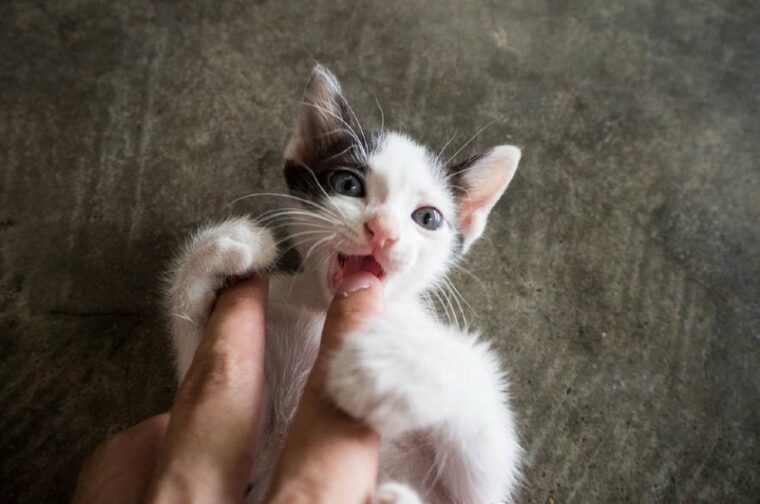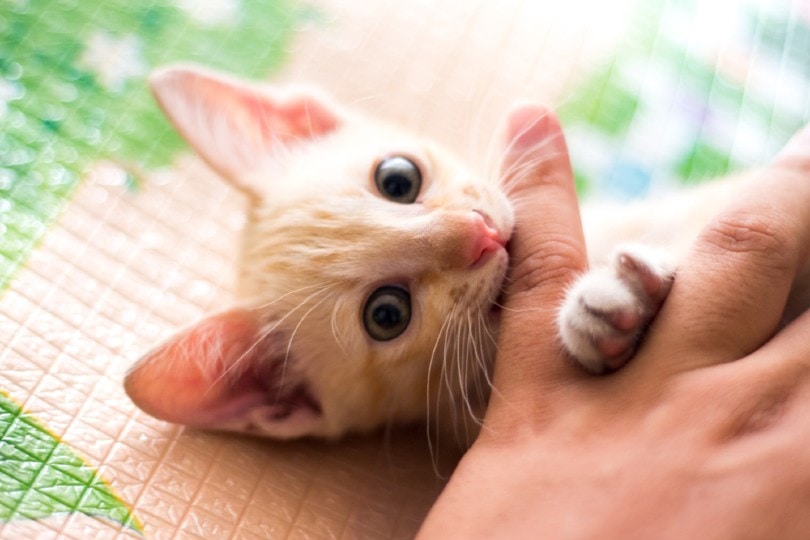
Click to Skip Ahead
If you have just brought home a kitten, you are hyped to be the best pet parent in the world. But what do you do if all your new pet does is bite and scratch?
Although kitten aggression is not as scary as adult aggression, it’s best to nip the behavior in the bud before it goes from bad to worse. Kittens start biting at three weeks and are at the height of social play between nine and 16 weeks. If you have a lone kitten, they can show what seems like aggression because they have no idea that bites and scratches hurt.
Read on to learn why your kitty can change from a cuddly pet to a wolverine in seconds. We will also share some practical tips to help address the behavior.
Why Is My Kitten So Aggressive?
Kittens are playful creatures, and what may seem like aggression is just a normal part of development. Once they start biting at three weeks, the behavior can escalate out of control by the time they are five months old. Moreover, they begin experimenting with their claws by nine months and don’t lose their kitten-like playfulness until they are 16 weeks or older.
In the ideal setting where a kitten remains with their mom and siblings, they will experiment with the use of their “fangs” and claws with their immediate family. This is why experts highly recommend adopting a pair of kittens instead of one. The two will teach each other important lessons, like how much force they should put in bites or scratches.
So, why is aggressive behavior a normal part of development?
Cats are natural predators and use their teeth and claws for hunting, killing, and shredding their catch. They have strong hunting instincts that help them survive in the world. It’s only natural for them to experiment with their “hunting gear” and want to bite and scratch things.

 What Does Kitten Aggression Look Like?
What Does Kitten Aggression Look Like?
There are two main reasons why kittens can be aggressive. The most obvious reason is they want to play. If you have seen your cat randomly attack your shoe, wrestle with it, and bite into the leather, they are probably just being playful.
Kittens can also show fear aggression as a result of exposure to unfamiliar stimuli, new environments, and even new experiences. This type of aggression looks somewhat similar to play aggression because it can also make a cat attack their target. However, you’ll also notice a display of other behaviors like hissing, flattened ears, and dilated pupils.
Let’s look into these types of aggression in more detail.
Play Aggression
The most common type of aggression displayed by kittens is play aggression. Kittens are naturally quite playful and energetic. If not raised with littermates or lack adequate play opportunities, they can get too excited during play sessions and display signs of aggression.
Generally, kittens love rough play. This, combined with their hunting instinct, makes it pleasurable for them to spend hours stalking, pouncing, biting, and clawing at everything, including their owners.
You may unknowingly enable the behavior by playing roughly with your pet and even offering treats after your sessions. This will only encourage them to stalk and pounce on your toes without warning the next time they want to play. Typically, kittens raised with their siblings learn not to bite and scratch too hard because their littermates retaliate or stop playing if hurt.
Unfortunately, a lone kitten cannot learn from their mom or littermates. You must actively master your kitten’s patterns and address play aggression without instilling fear or anxiety.
Fear Aggression
Kittens can also display fear aggression in response to an unfamiliar stimulus. They may even perceive petting or other forms of human touch as potentially threatening stimuli. Common signs of fear-based aggression include dilated pupils, flattened ears, bared teeth, arched back, and a tucked tail.
Unfortunately, fear aggression is a sign of stress. It indicates that your cat finds a specific stimulus unpleasant or associates it with a negative experience. Depending on the degree of threat perceived, they could take flight, freeze, or attack.
 Rough Play vs Play Aggression: What’s the Difference?
Rough Play vs Play Aggression: What’s the Difference?
All kittens love rough play. Although rough play and straight-out aggression may seem similar, there’s a fine line between the two. While the former is okay, the latter must be addressed before your kitten turns into an adult cat.
Rough play involves pouncing and hopping around, often with an arched back. However, an aggressive kitten will also want to grab your ankle, scratch, or bite your toes and hands. While rough play is quiet, and your cat will keep their ears erect, aggressive play involves hissing, growling, or ears turned toward the back of the head.

Top 5 Tips to Help Stop Kitten Aggression
Aggression is any form of threatening behavior towards humans or other animals. Although your kitty’s scratch or bite will not kill you, it can lead to pain, injury, and even the risk of infection. Generally, aggressive behavior is not something you can take lightly, lest it blows out of proportion.
Here are a few tips to help you diffuse or stop kitten aggression.
1. Identify and Avoid Triggers Where Possible
If your cat gets aggressive during playtime, go to another room, and lock the door behind you to ensure your pet understands that playing aggressively only deprives them of attention.
On the other hand, you should be more patient when dealing with fear aggression. In this case, identify the triggers and understand your kitty’s tolerance level to unwanted stimuli. Also, determine the reactive distance to stimuli like loud noises or other pets.
Depending on what works, remove fear aggression triggers, or increase the distance between them and your kitten. You can then slowly work towards desensitizing your cat against the things that make them fearful. When dealing with stimuli that cannot be avoided, consider implementing strategies to calm your pet down.
2. Help Your Cat Calm Down
One of the surest ways to make your cat calm down is to ensure they have a safe space they can call their own. Even a cat tree can suffice and act as a haven they can retire to when stressed or overwhelmed. You could also consider using cat pheromones to help reduce anxiety and stress-related behaviors.
Most importantly, react to your kitty’s fear aggression like a pro. Respond calmly and do not yell or punish your pet because this will only worsen their aggression.

3. Use Positive Reinforcement Training
Positive reinforcement training generally involves rewarding good behavior. First, let your kitten play with and on you, provided they remain gentle. Secondly, give your cat a time-out and stop playing or ignore them when they show signs of play aggression.
The third step is to offer another play session. After a minute or so of play, offer a reward if your cat doesn’t use their teeth or claws. Be consistent, and don’t inadvertently reward bad behavior.
4. Try Structured Playtime
Another practical tip is to create a playtime schedule. Kittens need 30 to 45 minutes of play daily, depending on breed. Schedule to play with your cat at specific times of the day for 10 to 15 minutes per session.
During your play sessions, get creative and use a range of toys, including interactive toys, puzzles, or even catnip toys. Even kittens love predictable routines and are likelier to behave desirably if they look forward to spending time with you.
5. Redirect Unwanted Behavior
It is perfectly okay to help your kitty maintain the desired behavior. You can do so by redirecting aggression before it happens.
For instance, start your play sessions with a variety of toys. Switch to something that doesn’t involve your pet playing with your hands or close to you when you see signs of play aggression. This will help them differentiate your hands from toys they can stalk, bite and scratch.
If your kitty is an ankle grabber, have a toy at hand when walking around your home. Toss the toy a few steps ahead of you to distract your pet and dissuade them from attacking your feet.
Final Thoughts
Have you seen your kitty hide behind furniture and wait until you walk by before they dash out and attack your ankles? Although it may seem funny, this nasty behavior is better off addressed before it gets out of control.
Fortunately, it is possible to fix aggression in kittens, provided you identify the concern early and proactively address it. Apart from the above tips, getting your kitten spayed or neutered can also help reduce aggressive tendencies, especially those innate to your pet’s breed.
If nothing seems to work, it may be time to talk to your vet or a licensed animal behaviorist for personalized advice.
Featured Image Credit: XINN, Shutterstock


 What Does Kitten Aggression Look Like?
What Does Kitten Aggression Look Like?



